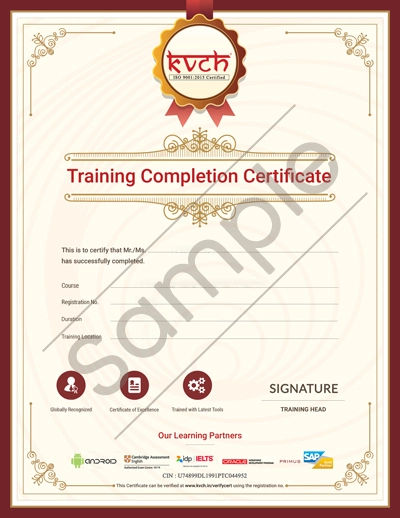Data Analytics Course Overview
Welcome to the Data Analytics course , a comprehensive program designed to equip you with the essential skills and knowledge needed to excel in the dynamic field of data analysis. This course covers a broad spectrum of topics, beginning with foundational concepts such as data collection, cleaning, and exploration. You'll gain hands-on experience with powerful analytical tools and techniques, including statistical analysis, data visualization, and predictive modeling.
The curriculum focuses on practical application, giving you the chance to work with real-world data and case studies. You'll explore advanced topics like machine learning and big data technologies, helping you gain the skills to draw actionable insights and make informed decisions. This course balances theory and hands-on experience, preparing you for a successful career in data analytics and enabling you to solve complex problems and drive innovation in various fields.
Throughout the course, you'll take part in interactive projects and assignments that reinforce your learning and showcase your skills. These projects will push you to apply analytical methods to real-life situations, improving your problem-solving abilities and your capacity to communicate your findings clearly. You'll also learn about industry best practices and ethical issues in data handling, ensuring you approach data analysis responsibly.
Our experienced instructors will guide you through each module, offering personalized feedback and support. Collaborative learning is a big part of the course, allowing you to work with classmates to share ideas and solve challenges together. By the end of the course, you’ll have built a strong portfolio of work that highlights your skills to potential employers, setting you up for success in this fast-changing field.
Whether you're looking to transition into a data-centric role, advance your current career, or simply gain a deeper understanding of data analytics, this course offers the tools and expertise needed to achieve your goals and make a significant impact in the world of data.
Data Analytics Course Curriculum
Topics: Python Basics
- Need for Programming
- Advantages of Programming
- Overview of Python
- Organizations using Python
- Python Applications in Various Domains
- Python Installation
- Variables
- Operands and Expressions
- Conditional Statements
- Loops
- Command Line Arguments
Topics: Data Structure and File Operations
- Method of Accepting User Input and eval Function
- Python - Files Input/Output Functions
- Lists and Related Operations
- Tuples and Related Operations
- Strings and Related Operations
- Sets and Related Operations
- Dictionaries and Related Operations
Topics: Functions and Object Oriented Programming
- User-Defined Functions
- Concept of Return Statement
- Concept of name=” main ”
- Function Parameters
- Different Types of Arguments
- Global Variables
- Global Keyword
- Variable Scope and Returning Values
- Lambda Functions
- Various Built-In Functions
- Introduction to Object-Oriented Concepts
- Built-In Class Attributes
- Public, Protected and Private Attributes, and Methods
- Class Variable and Instance Variable
- Constructor and Destructor
- Decorator in Python
- Core Object-Oriented Principles
- Inheritance and Its Types
- Method Resolution Order
- Overloading
- Overriding
- Getter and Setter Methods
- Inheritance-In-Class Case Study
Topics: Working with Modules and Handling Exceptions
- Standard Libraries
- Packages and Import Statements
- Reload Function
- Important Modules in Python
- Sys Module
- Os Module
- Math Module
- Date-Time Module
- Random Module
- JSON Module
- Regular Expression
- Exception Handling
Topics: Introduction to NumPy
- Basics of Data Analysis
- NumPy - Arrays
- Operations on Arrays
- Indexing Slicing and Iterating
- NumPy ArrayAttributes
- Matrix Product
- NumPy Functions
- Functions
- Array Manipulation
- File Handling Using NumPy
- Array Creation and Logic Functions
- File Handling Using Numpy
Topics: Data Manipulation Using Pandas
- Introduction to pandas
- Data structures in pandas
- Series Data Frames
- Importing and Exporting Files in Python
- Basic Functionalities of a Data Object
- Merging of Data Objects
- Concatenation of Data Objects
- Types of Joins on Data Objects
- Data Cleaning using pandas
- Exploring Datasets
Topics: Basics of Data Analysis
- What is Data Analytics?
- What does Data Analytics involve?
- Era of Data Analytics
- Business Intelligence vs Data Analytics vs Data Science
- Life Cycle of Data Analytics
- Tools of Data Analytics
- Application of Data Analytics
Topics: Exploratory Data Analysis
- Introduction
- Stages of Analytics
- CRISP DM Data Life Cycle
- Data Types
- Introduction to EDA
- First Business Moment Decision
- Second Business Moment Decision
- Third Business Moment Decision
- Fourth Business Moment Decision
- Correlation
Topics: Feature Engineering
- What is Feature
- Feature Engineering
- Feature Engineering Process
- Benefit
- Feature Engineering Techniques
Topics: Inferential Statistics & Hypothesis Testing
- Basics Of Probability
- Discrete Probability Distributions
- Continuous Probability Distributions
- Central Limit Theorem
- Concepts Of Hypothesis Testing - I: Null And Alternate Hypothesis, Making A Decision, And Critical
- Value Method
- Concepts Of Hypothesis Testing - II: P-Value Method And Types Of Errors Industry Demonstration
- Of Hypothesis Testing: Two-Sample Mean And Proportion Test, A/B Testing
Topics: Getting Started and Creating, Selecting & Retrieving Data with SQL
- Introduction to Databases
- How to create a Database instance on Cloud?
- Provision a Cloud hosted Database instance.
- What is SQL?
- Thinking About Your Data
- Relational vs. Transactional Models ER Diagram
- CREATE Table Statement and DROP tables
- UPDATE and DELETE Statements
- Retrieving Data with a SELECT Statement
- Creating Temporary Tables
- Adding Comments to SQL
Topics: Filtering, Sorting, and Calculating Data with SQL
- Basics of Filtering with SQL
- Advanced Filtering: IN, OR, and NOT
- Using Wildcards in
- SQL Sorting with ORDER BY
- Math Operations
- Aggregate Functions
- Grouping Data with SQL
Topics: Subqueries and Joins in SQL
- Using Subqueries
- Subquery Best Practices and Considerations
- Joining Tables
- Cartesian (Cross) Joins
- Inner Joins
- Aliases and Self Joins
- Advanced Joins: Left, Right, and Full Outer Joins
- Unions
Topics: Modifying and Analyzing Data with SQL
- Working with Text Strings
- Working with Date and Time Strings
- Date and Time Strings Examples
- Case Statements
- Views
- Data Governance and Profiling
- Using SQL for Data Science
Topics: Accessing Databases using Python
- How to access databases using Python?
- Writing code using DB-API
- Connecting to a database using DB API
- Create Database Credentials
- Connecting to a database instance
- Creating tables, loading, inserting, data and querying data
- Analyzing data with Python
Excel 2007 & 2010, 2013, 2016 Quick Overview
- Difference between Excel 2003, 2007 and 2010,2013,2016
- Use of Excel, its boundaries & and features
Basic Formula
- Formulae that Add / Subtract / Multiply / Divide
- BODMAS/Formula Error Checking
- The Sum Function
Absolute Referencing
- Formulae that Add / Subtract / Multiply / Divide
- BODMAS/Formula Error Checking
- The Sum Function
PivotTables
- Creating and formatting Simple PivotTables
- Page Field in a PivotTable
- Formatting a PivotTable
- Creating / Modifying a PivotChart
Logical Functions
- IFs and Nested IF Functions
- Using AND/OR / NOT Functions
Statistical Functions
- Using The SUMIF / COUNTIF Functions
- Using The AVERAGE/COUNT/LARGER/SMALLER Functions
Pivot Tables - Advance
- Adding new calculated Fields/Items
- Changing the Summary Function
- Consolidate Pivot table
LOOKUP Functions - Advance
- MATCH with VLOOKUP Functions
- INDEX & MATCH Functions
- OFFSET / INDIRECT functions
Logical Functions - Advance
- If Loop and Nested IF Loop Functions
- Using IF/ISERROR Functions
Chart Data Techniques
- The Chart Wizard
- Chart Types
- Adding Title / Legends / Labels
- Printing Charts
- Adding Data to a Chart
- Formatting / Renaming/Deleting Data Series
- Changing the Order of Data Series
Date/Time Functions
- Using The Today
- Now & Date Functions
- Using The Datedif / Networkdays/Eomonth Functions
- Using The Weeknum Functions
- Using The Edate / Networkdays. Intl/Weekdays.Intl Functions
Text Functions Using
- The Mid/Search / Left/Right Functions
- Using The Trim / Clean / Upper/ Lower Functions
- Using The Substitute / Text Functions
- Using The Trim / Clean / Proper / Dollar Function
Validations
- Input Messages/ Error Alerts / Drop-Down Lists
- Conditional Formatting
Advanced Filters
- Sorting by Top to Bottom / Left to Right Creating / Deleting Custom List
- Sort by using the Custom List
Hyper / Data Linking
- Hyperlinking data, within a sheet/workbook
- Linking & Updating links between workbooks & application
- Introduction to Data Visualization
- Tableau Introduction and Tableau Architecture
- Exploring Data using Tableau
- Working with Data using Tableau including Data Extraction and
- Blending
- Various Charts in Tableau (Basics to Advanced)
- Sorting-Quick Sort, Sort from Axis, Legends, Axis, Sort by Fields
- Filtering- Dimension Filters, Measure Filters, Date Filters, Tableau
- Context Filters
- Groups, Sets, and Combined Sets
- Reference Lines, Bands, and Distribution
- Parameters, Dynamic Parameters, and Actions
- Forecasting-Exponential Smoothening Techniques
- Clustering
- Calculated Fields in Tableau, Quick Tables
- Tableau Mapping Features
- Tableau Dashboards, Dashboards Action, and Stories
Topics: Introduction To Power BI
- Introduction to Power BI-Need, Imprtance
- Power BI - Advantages and Scalable Options
- Power BI Data Source Library and DW Files
- Business Analyst Tools, MS Cloud Tools
- Power BI Installation
- Power BI Desktop - Instalation, Usage
- Sample Reports and Visualization Controls
- Understanding Desktop & Mobile Editions
- Report Rendering Options and End User Access
Topics: Creating POWER BI Reports, Auto Filters
- Report Design with Databse Tables
- Report Visuals, Fields and UI Options
- Reports with Multiple Pages and Advantages
- Pages with Multiple Visualizations. Data Access
- “GET DATA” Options and Report Fields, Filters
- Report View Options: Full, Fit Page, Width Scale
- Report Design using Databases & Queries
Topics: Report Visualization And Properties
- Power BI Design: Canvas, Visualizations, and Fileds
- Import Data Options with Power BI Model, Advantages
- Data Fields and Filters with Visualizations
- Visualization Filters, Page Filters, Report Filters
- Creating Customised Tables with Power BI Editor
- General Properties, Sizing, Dimensions, and Positions
- Grid Properties (Vertical, Horizontal) and Styles
- Page Level Filters and Report Level Filters
- Visual-Level Filters and Format Options
- Report Fields, Formats and Analytics
Topics: Chart And Map Report Properties
- CHART Report Types and Properties
- STACKED BAR CHART, STACKED COLUMN CHART
- CLUSTERED BAR CHART, CLUSTERED COLUMN CHART
- Field Properties
- Formats: Legend, Axis, Data Labels, Plot Area
- Data Labels: Visibility, Color and Display Units
- Analytics: Constant Line, Position, Labels
- Map Reports: Working with Map Reports
- Hierarchies: Grouping Multiple Report Fields
- Advanced Query Mode @ Connection Settings - Options
Topics: DAX EXPRESSIONS
- Purpose of Data Analysis Expresssions (DAX)
- Scope of Usage with DAX. Usabilty Options
- DAX Context: Row Context and Filter Context
- DAX Entities: Calculated Columns and Measures
- DAX Data Types: Numeric, Boolean, Variant, Currency
- Datetime Data Tye with DAX. Comparison with Excel
- DAX Operators & Symbols. Usage. Operator Priority
- Parenthesis, Comparison, Arthmetic, Text, Logic
- DAX Functions and Types: Table Valued Functions
- Filter, Aggregation and Time Intelligence Functions
- Information Functions, Logical, Parent-Child Functions
- Statistical and Text Functions. Formulas and Queries
- Syntax Requirements with DAX. Differences with Excel
- Naming Conventions and DAX Format Representation
- Working with Special Characters in Table Names
- Attribute / Column Scope with DAX-Examples
- Measure / Column Scope with DAX-Examples
Select the best course are per your career need and enhance your skills with us
The KVCH Internship program is the core of our organization and the foundation for our ability to drive results for upcoming Talents. The excellent management pillar at KVCH focuses on providing advice on best and innovative management practices to enhance operational and career-driven performance.
KVCH offers a Task and project-based Internship Training Program with an assortment of courses given at Noida. The program length goes from 4 to 24 weeks, contingent upon the student's understudy needs and the investment of prepared accomplice trainers and experts to carry out the educational plan and direct the students all through the program. A cluster with a huge understudy mentor proportion typically incorporates around 50-60 members. Training certificates will be offered to fruitful endless supply of the program.











.webp)
.webp)
.webp)
.webp)
.webp)
.webp)
.webp)
.webp)
.webp)
.webp)
.webp)
.webp)
.webp)
.webp)
.webp)
.webp)
.webp)
.webp)
.webp)
.webp)
.webp)
.webp)






























